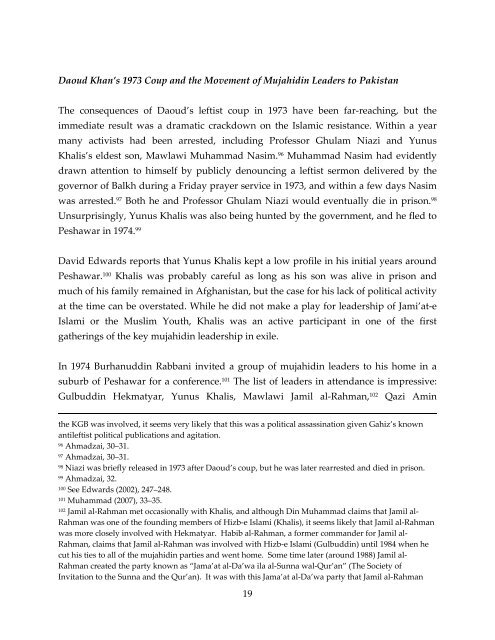Usama bin Ladin’s “Father Sheikh”:
Usama bin Ladin’s “Father Sheikh”:
Usama bin Ladin’s “Father Sheikh”:
You also want an ePaper? Increase the reach of your titles
YUMPU automatically turns print PDFs into web optimized ePapers that Google loves.
Daoud Khan’s 1973 Coup and the Movement of Mujahidin Leaders to Pakistan<br />
The consequences of Daoud’s leftist coup in 1973 have been far‐reaching, but the<br />
immediate result was a dramatic crackdown on the Islamic resistance. Within a year<br />
many activists had been arrested, including Professor Ghulam Niazi and Yunus<br />
Khalis’s eldest son, Mawlawi Muhammad Nasim. 96 Muhammad Nasim had evidently<br />
drawn attention to himself by publicly denouncing a leftist sermon delivered by the<br />
governor of Balkh during a Friday prayer service in 1973, and within a few days Nasim<br />
was arrested. 97 Both he and Professor Ghulam Niazi would eventually die in prison. 98<br />
Unsurprisingly, Yunus Khalis was also being hunted by the government, and he fled to<br />
Peshawar in 1974. 99<br />
David Edwards reports that Yunus Khalis kept a low profile in his initial years around<br />
Peshawar. 100 Khalis was probably careful as long as his son was alive in prison and<br />
much of his family remained in Afghanistan, but the case for his lack of political activity<br />
at the time can be overstated. While he did not make a play for leadership of Jami’at‐e<br />
Islami or the Muslim Youth, Khalis was an active participant in one of the first<br />
gatherings of the key mujahidin leadership in exile.<br />
In 1974 Burhanuddin Rabbani invited a group of mujahidin leaders to his home in a<br />
suburb of Peshawar for a conference. 101 The list of leaders in attendance is impressive:<br />
Gulbuddin Hekmatyar, Yunus Khalis, Mawlawi Jamil al‐Rahman, 102 Qazi Amin<br />
the KGB was involved, it seems very likely that this was a political assassination given Gahiz’s known<br />
antileftist political publications and agitation.<br />
96 Ahmadzai, 30–31.<br />
97 Ahmadzai, 30–31.<br />
98 Niazi was briefly released in 1973 after Daoud’s coup, but he was later rearrested and died in prison.<br />
99 Ahmadzai, 32.<br />
100 See Edwards (2002), 247–248.<br />
101 Muhammad (2007), 33–35.<br />
102 Jamil al‐Rahman met occasionally with Khalis, and although Din Muhammad claims that Jamil al‐<br />
Rahman was one of the founding members of Hizb‐e Islami (Khalis), it seems likely that Jamil al‐Rahman<br />
was more closely involved with Hekmatyar. Habib al‐Rahman, a former commander for Jamil al‐<br />
Rahman, claims that Jamil al‐Rahman was involved with Hizb‐e Islami (Gulbuddin) until 1984 when he<br />
cut his ties to all of the mujahidin parties and went home. Some time later (around 1988) Jamil al‐<br />
Rahman created the party known as “Jama’at al‐Da’wa ila al‐Sunna wal‐Qur’an” (The Society of<br />
Invitation to the Sunna and the Qur’an). It was with this Jama’at al‐Da’wa party that Jamil al‐Rahman<br />
19


